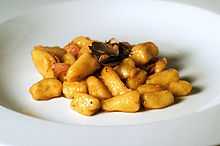Gnocchi
| Gnocchi | |
|---|---|
|
Gnocchi di ricotta, dressed in butter and sage | |
| Type | Dumpling |
| Course | Entrée |
| Place of origin | Italy |
| Main ingredients | Potatoes (or semolina or wheat flour or breadcrumbs); sometimes eggs, cheese |
| Variations | Malfatti, cavatielli |
|
| |
Gnocchi (/ˈnʲɒki/ N(Y)OK-ee, also US /ˈnjoʊki/, NYOH-kee; Italian: [ˈɲɔkki], singular gnocco) are various thick, soft dough dumplings that may be made from semolina,[1] ordinary wheat flour,[2] egg,[3] cheese,[4] potato,[5] breadcrumbs,[6] or similar ingredients.[7][8][9]
Like many Italian dishes, there is considerable variation in recipes and names across different regions. For example, the Tuscan malfatti (literally "poorly made") are a sort of flour, ricotta, and spinach gnocchi;[10] the Pugliese cavatielli are flour-based, gnudi have much less flour,[11] and so on.[12]
Gnocchi are eaten as a first course (primo piatto), as an alternative to soups (minestre) or pasta. They are generally home-made in Italian and diaspora Italian households. They may also be bought fresh from speciality stores. In supermarkets, industrially produced packaged gnocchi are widely available refrigerated, dried, or frozen. Common accompaniments of gnocchi include melted butter with sage, pesto, and various sauces.
Origin
The word gnocchi may derive from the Italian word nocchio, meaning a knot in wood,[13] or from nocca (meaning knuckle).[14] It has been a traditional Italian pasta type of probable Middle Eastern origin since Roman times.[15] It was introduced by the Roman legions during the expansion of the empire into the countries of the European continent. In the past 2,000 years, each country developed its own specific type of small dumpling, with the ancient gnocchi as their common ancestor. In Roman times, gnocchi were made from a semolina porridge-like dough mixed with eggs, and are still found in similar forms today, particularly the oven-baked gnocchi alla romana and Sardinia's malloreddus (although these do not contain eggs).
The use of potato is a relatively recent innovation, occurring after the introduction of the potato to Europe in the 16th century.[16] Potato gnocchi are particularly popular in Abruzzo, Friuli-Venezia Giulia, Veneto, Ciociaria and other provinces of Latium. As with other mashed potato dishes they are best prepared with starchy potatoes to keep a light texture.
Regional varieties
One variety, gnocchi di pane (literally "bread lumps"), derived from the Semmelknödel, is made from breadcrumbs and is popular in Friuli-Venezia Giulia, Veneto and Trentino-Alto Adige/Südtirol. Another variety from the latter region is spinach gnocchi.
Croatia
Gnocchi are a very popular and often served dish in coastal Croatia, typically being served as a first course or a side dish with Dalmatinska pašticada. The Croatian name for Gnocchi is 'njoki'.
France
The name is also used in France in the dish known as "gnocchis à la parisienne", a hot dish comprising gnocchi formed of choux pastry, and served with Béchamel sauce.
In Nice, the "gnocchi de tantifla a la nissarda" is made with potatoes, and wheat flour.[17] It is a refined speciality in Nice.
There is another variant of the "gnocchi de tantifla a la nissarda". It's "la merda dé can", literally, the dog shit. It is made with potatoes, wheat flour, eggs and 'blette' (Swiss Chard), which is also used for the "tourte de blette". "La merda dé can" is longer than the original gnocchi.
South America
Due to the significant number of Italian immigrants who arrived in Argentina, Brazil, Paraguay and Uruguay, gnocchi, ñoqui (Spanish, [ˈɲoki]) or nhoque (Portuguese, pronounced: [ˈɲɔki]) is a popular dish, even in areas with few Italian immigrants. In Brazil, Uruguay, Paraguay and Argentina there is a tradition of eating gnocchi on the 29th of each month, with some people putting money beneath their plates to bring prosperity.
Confusion

In some places gnocchi, as they are an Italian dish, are considered a kind of pasta, when in fact in Italy they are seen as an alternative to pasta. However, some producers have real pasta shaped and named as gnocchi.
Gallery
|
See also
References
- ↑ Vincenzo Buonassisi, Il nuovo codice della pasta, Rizzoli 1985, recipe #850-853
- ↑ Buonassisi, recipe #831-833
- ↑ Buonassisi, recipe #837-838
- ↑ Buonassisi, recipe #839-840
- ↑ Buonassisi, recipe #854-857
- ↑ Buonassisi, recipe #877 "Al Pien... si tratta di gnocchi, delicatissimi, secondo un'antica ricetta mantovana..."
- ↑ Waverley Root, The Food of Italy, 1971 passim
- ↑ Luigi Carnacina, Luigi Veronelli, La cucina rustica regionale (4 vol.), Rizzoli 1966, passim
- ↑ Accademia Italiana della Cucina, La Cucina: The Regional Cooking of Italy, tr. Jay Hyams, Rizzoli, 2009, passim
- ↑ Buonassisi, recipe #875
- ↑ Royer, Blake (April 15, 2010). "Homemade Gnudi from The Spotted Pig". Retrieved 2014-05-12.
- ↑ Buonassisi, recipe #895
- ↑ Oxford English Dictionary, 2nd Edition. Oxford University Press. 1989.
- ↑ Lo Zingarelli, 2008.
- ↑ Serventi, Silvano; Françoise Sabban (2002). Pasta: The Story of a Universal Food. Trans. Antony Shugaar. New York: Columbia University Press. p. 17. ISBN 0-231-12442-2.
- ↑ Theisen, K. "World Potato Atlas: China - History and Overview". International Potato Center.
- ↑ Traditions et Cuisine du pays Niçois, Recettes Niçoises de nos Grands-Mères. Myriam GARNERONE, Editions CPE. June 2008.
Further reading
- Davidson, Alan. The Oxford Companion to Food, s.v. gnocchi.
- Jenkins, Nancy Harmon. Flavors of Tuscany. 1998.
- GARNERONE, Myriam. "Traditions et Cuisine du pays niçois, Recettes Niçoises de nos Grands-Mères". 2008.
External links
![]() Media related to Gnocchi at Wikimedia Commons
Media related to Gnocchi at Wikimedia Commons
| Look up gnocchi in Wiktionary, the free dictionary. |
| ||||||||||||||||||||||||||||||||||||||||||||||||||||||||||||||||||||||||||



